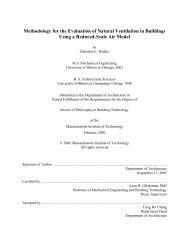DSTL (PDF) - Cham
DSTL (PDF) - Cham
DSTL (PDF) - Cham
Create successful ePaper yourself
Turn your PDF publications into a flip-book with our unique Google optimized e-Paper software.
is used when turbulence is to be modelled. The constant C 3ε in the ε equation is then set equalto 0.2 as recommended for stable stratification [3]. Bathymetry is modelled using cellporosity.The bottom surface stress (first study case only) is included as a source (S 1 ) for the horizontalmomentum equation with a value calculated using the flow velocity u 1 at 1m from the seabottom and a drag coefficient C D of 0.0025 [4]. The values k sb , ε sb at the grid node distance y sbfrom the sea bottom are calculated from expressions assuming equality of production anddissipation of turbulence (the equilibrium assumption, [5]), giving3S12( )1 S1ρS1= −CDρu1u1, ksb= , εsb=0.3 ρ 0.4ysbField values of k, ε , when turbulence is modeled, are initialised at t=0 to 10 -6 (m 2 /s 2 ) and10 -9 (m 2 /s 3 ) respectively. Initial waveforms are prescribed in the domain from mathematicalapproximations or measured values. The ocean surface is represented as a rigid free slip lid togood approximation since the surface elevations induced by internal waves are smallcompared to the internal wave amplitude. The lateral boundaries can be either inflow oroutlow (fixed ambient hydrostatic pressure) for the first case or cyclic for the second case.CASE STUDIES1. Large amplitude, shoaling internal waves in the South China SeaLarge amplitude internal waves are a common feature of the World’s oceans and arefrequently observed near regions of rapidly varying topography where tidal forces distortstable ocean stratification. Internal waves are important because they cause distortion ofacoustic propagation paths, and produce localised current pulses which can affect drillingoperations, submersible stability and water clarity due to sediment resuspension.Recent measurements taken as part of the Office of Naval Research (ONR) sponsored AsianSeas International Acoustics Experiment (ASIAEX, 2001) in the South China Sea haveprovided detailed in situ evidence of many internal wave features previously inferred fromsatellite or theory. Relevant internal wave results from this experiment are reported by Orr andMignerey [6] who show observations of internal waves of depression propagating intoshallow water transformed into internal waves of elevation, a process that was expected fromtheory (Grimshaw [7]) and suggested by Liu [8] from satellite images.PHOENICS has been used to simulate the propagation of large amplitude internal wavesacross water depths from 260m to 100m. The aim has been to assess the capability of a CFDcode to reproduce the essential characteristics of the internal wave phase speed, shape and ,localised currents by comparison with the observations from ASIAEX. The details of thelocation and ship track during the measurement programme of ASIAEX are shown in Figure1. The background stratification is taken from Conductivity, Temperature and Depth (CTD)2
















